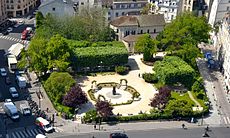Square René Viviani

Overview with the church of Saint-Julien-le-Pauvre in the background
|
|
| Length | 128 m (420 ft) |
|---|---|
| Arrondissement | 5th |
| Quarter | Quartier Latin |
| Construction | |
| Completion | 1928 |
| Denomination | René Viviani-Montebello |
The Square René Viviani (Official French name: Square René Viviani-Montebello) is a public square adjacent to the Church of Saint-Julien-le-Pauvre in the 5th arrondissement of Paris.
The Square René Viviani is a city park located slightly to the north of the Gothic church of Saint-Julien-le-Pauvre, built at the same time as Notre-Dame Cathedral and consequently one of Paris' oldest churches. Disaffected during the Revolution, in the 19th century the ruinous church was taken over by the city's Greek Melchite Church and is today the center of that religious community in Paris. The Square is an irregular polygon in shape, bounded by the Rue Galande and church buildings to the south; by the Rue Saint-Julien-le-Pauvre on the west; by the Quai de Montebello to the north; and by the Rue Lagrange and the Rue du Fouarre on the east. The Rue de la Bûcherie ends on the western side of the square, but it resumes its course on the eastern side, and the Pont au Double, a bridge to the Île de la Cité, lies across the Quai de Montebello from the square. The Square René Viviani offers one of the best views of the Cathedral of Notre Dame in all of Paris.
Around the corner, in the Rue de la Bûcherie, stands the well-known English-language bookshop, Shakespeare and Company which took the name of Sylvia Beach's legendary bookshop and independent publishing house near the Place de l'Odéon, which first published James Joyce's novel Ulysses and was a literary center for English writers until it was definitively closed when Germany occupied France.
Inside the square, there are two features, other than the lawns, walkways, well-trimmed plane trees, and benches, that deserve a mention here. There is an odd-looking fountain, known as the Saint Julien fountain, that was erected in 1995. It is the work of the French sculptor, Georges Jeanclos (1933–1997), and it is emblematic of the legend of St. Julien the Hospitaller, a tale, now largely discounted, involving a curse by witches, a talking deer, a case of mistaken identity, an horrific crime, several improbable coincidences, and a supernatural intervention. The story was told and retold during the Middle Ages, and it became a favorite. Consequently, hospitals, hospices, and churches all over Europe adopted Julien as their patron. He was also a patron saint of hunters, innkeepers, and ferrymen; traveling pilgrims often prayed for his help in finding comfortable lodgings.
...
Wikipedia

